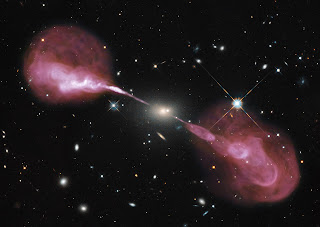With the help of the Hubble telescope and the Very Large Array (VLA) radio telescope, researchers detected a spectacular jet driven by the gravitational energy of a supermassive black hole at the core of the elliptical galaxy Hercules A. In the center of the picture above, we can see how the yellow elliptical galaxy appears normal enough to be seen by Hubble's Hubble in visible wavelengths of light.
The elliptical galaxy is about two billion light-years away from our solar system, about 1,000 times more massive than the bulge of our Milky Way, discovery suggests it contains a 2.5-billion-solar-mass central black hole, Which is 1,000 times more massive than the black hole of our Galaxy. But there is an innocuous 3C 348 galaxy, long positioned in the Hercules constellation, known as the brightest radio-emitting object.
The radio wavelength of 3C 348 galaxy emits about a billion times more power than ours, making it one of the brightest extragalactic radio sources in the sky when viewed in the sky.
An invisible jet measuring one and a half million light-years wide that dwarfs the visible galaxy, the VLA reveals this invisible giant jet optically. A jet consists of a very high-energy plasma beam and subatomic particles, as well as a magnetic field at its center, which attracts gas and dust. The unusual ring structures seen in the outer part of both jets, the researchers say, suggest to us the history of explosions from the supermassive black hole at the center of the galaxy.
The innermost parts are not visible due to the excessive velocity of the material in the jet, the relativistic effect aligns all the light with the jet, and is confined to a narrow cone, so the light cannot be seen by us. Due to the distance from the galaxy, the jets become unstable, due to which their rings and blows break.
All radio sources of gas that are extremely hot, surrounded by clouds of X-ray emitters, cannot be seen in the optical-radio composite.
Hubble depicts an elliptical galaxy very close to the center of the optical-radio source, which once merged with the central galaxy. Hubble's data suggests that many other elliptical and spiral galaxies could be part of a group in the future, researchers say.



Comments